No products in the cart.
Mongolian Rangers Venture Forth
The small village of Sauraha sits right across the Rapati river from Chitwan National Park, Nepal’s most famous protected area outside of Sagarmatha and Mount Everest. The village is a tidy, well run tourist town that accommodates one of the most sought after attractions that Nepal has to offer, the Asian one horned rhino, the largest in the world займ онлайн без отказа. The rhinos protection from poaching is one of wildlife conservations success stories. Although an occasional poaching will occur, there are more than 600 Asian rhino’s roaming the park, protected by the Nepalese army and the Department of National Parks. So many, that a few individuals make it across the Rapati river and saunter the main streets of Sauraha like a slow moving tank. Traffic stops, tourists and locals alike scramble for the side of the street, into t-shirt and souvenir shops, bars and restaurants, phone videos churning away as the biggest rhinos on earth methodically pass by. Even the working elephants protest and give way to these behemoths. Just another main street attraction, but quite a unique one.
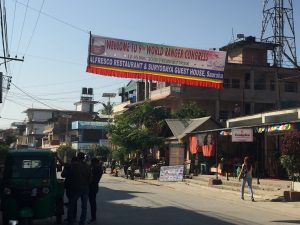
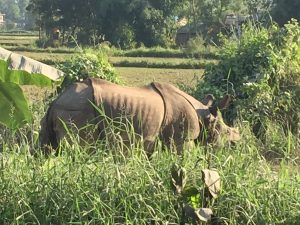
Sharing a border with India, Chitwan NP, with its subtropical forests of tall Sal trees that cover 70% of the park and the grasslands of the Terai alluvial floodplain, the park is also home to Asian elephants, Royal Bengal tigers, sloth bear, striped hyena, Indian wild dogs, palm civets, honey badgers, golden jackal, spotted deer, langar monkey’s, wild boar and over 500 species of birds. It is an amazing park to visit with its dense forest and open grassland, especially in the early morning with the awakening of the dawn chorus, a symphony of bird song.
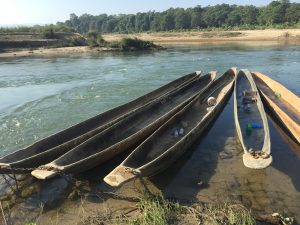
So, why am I writing about this? And why were we in Nepal with seven Mongolian Rangers? We’re supposed to be on horseback riding the steppes, forests and mountains of Mongolia.
Well, Sauraha with its well-appointed resorts and forest hotels and the Chitwan NP nearby, were the perfect location and venue for the 9th World Ranger Congress, an event put on every three years by the International Ranger Federation and hosting conservation, environmental and wildlife rangers from around the world. This 2019 congress held in Nepal and Asia for the first time, was the biggest, with more than 550 rangers from all continents attending. It seemed this was the right time for Mongolia to be represented at this growing event. Stone Horse, with its commitment to and former experience with ranger work and park management, stepped in and worked for a year with Mongolian rangers E. Battulga and T. Chingel of the Ulaabaatar Environmental Department to make it happen. We supported the group with funding and advice and with additional financial help from The Thin Green Line, the charity arm of the International Ranger Federation, we were able to make it to this 9th World Ranger Congress.
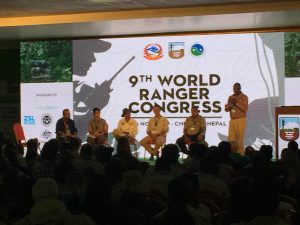
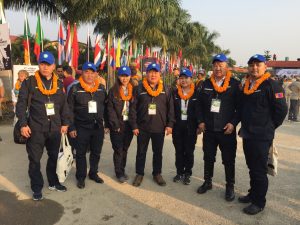
Stone Horse Conservation Efforts in Mongolia
Because we explore the Khentii Mountains in Mongolia with our horse-riding expeditions and roam through both the Gorkhi-Terelj National Park and the Khan Khentii Special Protected Area, it’s important for us to cooperate with and support the people who protect these areas, the park administrations and the frontline rangers. With our Wilderness Conservation Adventure Expedition, we design conservation trips that allow our guests to enjoy an amazing wilderness horse trip, while spending time alongside working rangers and together undertake conservation and environmental work that helps protect the park, address visitor management and help foster good relations between tourism and protected area management. We aim to support and protect the protectors while at the same time provide a learning experience and a conservation contribution for our clients while riding through a majestic “National Geographic like” wilderness, as one guest put it.
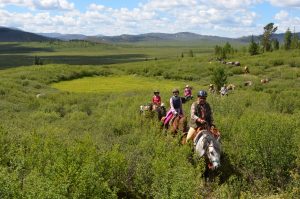
We also work with the Ulaanbaatar Capital City Environmental Rangers, who have management and patrolling jurisdiction over more than one million acres of wild land within the Ulaanbaatar city limits. This is where the Stone Horse cabins and staging area is located, with the surrounding rural and wild part of the city bigger in size than many national parks around the world. Home to wildlife such as brown bear, wolves, martin, roe deer, elk, wolverine, Eurasian lynx, wild boar, golden eagles and other birds of prey, as well as marmot, beaver, ground squirrels and a host of other important small critters and birds. The area also encompasses, wetlands and forests of Siberian larch, pine and spruce, birch and aspen along with a variety of medicinal plants. The rangers have their work cut out for them, as it is also under threat from development, illegal logging, land grabs and wildlife poaching. Due to this and its proximity to the largest population center in the country, the UB Environmental Rangers are probably the most experienced conservation rangers in the country with the challenges they must deal with on a daily basis.
Years of working with Mongolian Rangers
In earlier work throughout Mongolia, it became clear that with all its national parks, special protected areas, natures reserves and local protected areas, individual rangers faced enormous management and patrolling problems. They have massive territories to cover, often alone, without back up, no communications and traveling by horse or motorcycle. Not easy in the severe winters this country experiences. Like conservation rangers in many countries, they are understaffed, undertrained, under equipped and underpaid, yet hold a passion for their jobs in protecting wild places that is astounding given the above. They are supported as much as possible by the Ministry for the Environment considering the budget allocations allowed each year. However, more can be done to support their work and livelihood. This is where the idea of forming a ranger association came about, and joining with the international community of rangers through the International Ranger Federation. Our trip to the 9th World Ranger Congress in Nepal was an unimaginable learning exercise for the seven rangers who attended. Meeting for a week long session with rangers and like-minded people from far flung lands, sharing experiences and contributing to the Chitwan Declaration which came out of the Congress. Returning from that event gave energy to put together the first Mongolian Ranger Association, a non-government organization of rangers and frontline staff, with the purpose of supporting each other in their work with information sharing, education opportunities, equipment exchanges and creating public awareness about ranger work and their importance to protected areas.
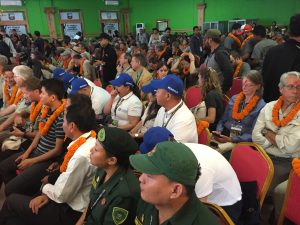
A Mongolian Ranger Association?
Upon returning to Mongolia in late November of 2019, the normal business of getting back to work, the rangers with their daily patrolling and inspections and preparing for winter. My work with Stone Horse Expeditions, repairing equipment for next season, corresponding with guest inquiries and looking forward to a trip promoting our horse-riding expeditions in several surrounding countries, something I do every winter. Plans were made to begin the steps of creating a Mongolian Rangers Association early in the new year. Then, of course we all know what happened in January. Mongolia acted swiftly, following the World Health Organizations guidelines concerning the COVID-19 outbreak, requiring masks, social distancing, closing schools, businesses, banning meetings and public gatherings, limiting in-county travel and by March, closing the borders to all incoming travelers. This of course has saved the country and prevented the small healthcare system here from being overwhelmed. There have been no deaths in Mongolia as of this writing due to coronavirus.
These strict measures saved the country and no doubt many lives, and can be seen as a success, but it has also caused economic hardship, especially in the tourism and hospitality sector. To say businesses went off a cliff is an understatement. The idea of following the momentum created at the World Ranger Congress and returning to Mongolia to form a conservation ranger association seemed unimportant considering the situation and was put on the back burner….but on low heat.
Mongolia gets little to no media mention on the world stage for its success in stopping COVID-19 from devastating the country. You rarely read about it in the international news or big media sites. Yet, it is a great success and life is pretty much normal here. No international visitors and an economy hanging on by a thread, but we can move around the country freely, shops and restaurants are open and life goes on. It will open when it is safe to do so, according to the president. And, as I started with this story about Nepal, the World Ranger Congress, rangers and their work, we are now again moving to create Mongolia’s first ranger association. An organization that will help protect the protectors, the men and women who dedicate themselves to a sometimes dangerous, thankless job, so we can still have these wonderful parks and protected areas to travel in and hopefully leave for future generations.
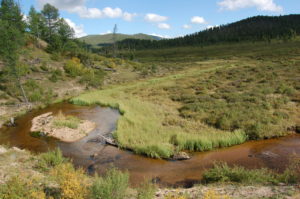
Stone Horse Expeditions is proud to help and support this effort and will continue its partnership with the national park and protected area administrations and the working rangers of Mongolia. As users of these natural areas, it’s our responsibility to do what we can to make sure our guests experience nature at its finest and leave with a feeling of satisfaction and an understanding of this country’s great wild nature, culture and those that dedicate their lives to keep it that way.
If you’re interested in helping the Mongolian Ranger Association, contact me, [email protected]
Keith is the co-owner and founder of Stone Horse Expeditions and has years of international experience as a ranger, wildlife sanctuary manager, advisor to national parks and ranger training and is an Associate Ranger with the International Ranger Federation.
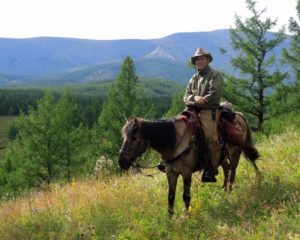
What is a Ranger?
The term “ranger” is used to describe those who work in the conservation field and can be called a wildlife ranger, warden, forest guard, game scout, community ranger, etc. These terms vary from country to country, but all cover similar jobs protecting the environment, wildlife, forests, seascapes, national parks and protected areas.


